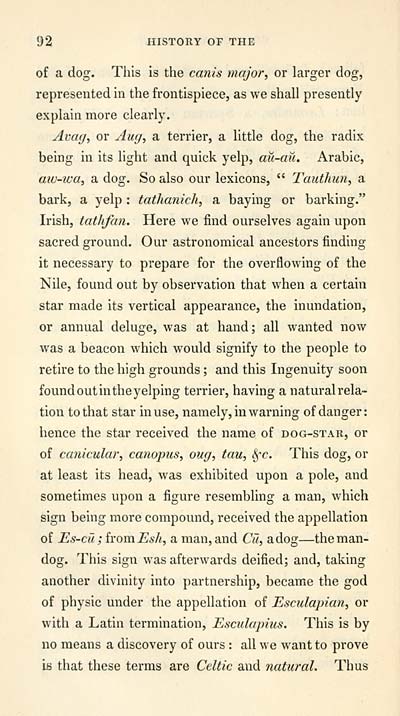Download files
Complete book:
Individual page:
Thumbnail gallery: Grid view | List view

92 HISTORY OF THE
of a dog. This is tiie canis major, or larger dog,
represented in the frontispiece, as we shall presently
explain more clearly.
Avag, or Aug, a terrier, a little dog, the radix
being in its light and quick yelp, au-aii. Arabic,
aw-wa, a dog. So also our lexicons, " Tcmthun, a
bark, a yelp : tathanich, a baying or barking."
Irish, tathfan. Here we find ourselves again upon
sacred ground. Our astronomical ancestors finding
it necessary to prepare for the overflowing of the
Nile, found out by observation that when a certain
star made its vertical appearance, the inundation,
or annual deluge, was at hand; all wanted now
was a beacon which would signify to the people to
retire to the high grounds ; and this Ingenuity soon
found out in the yelping terrier, having a natural rela-
tion to that star in use, namely, in warning of danger:
hence the star received the name of dog-star, or
of canicular, canopus, oug, tau, Sfc. This dog, or
at least its head, was exhibited upon a pole, and
sometimes upon a figure resembling a man, which
sign being more compound, received the appellation
of Es-cu; h'omEsh, a man, and Cu, a dog — the man-
dog. This sign was afterwards deified; and, taking
another divinity into partnership, became the god
of physic under the appellation of Esculapian, or
with a Latin termination, Esculapius. This is by
no means a discovery of ours : all we want to prove
is that these terms are Celtic and natural. Thus
of a dog. This is tiie canis major, or larger dog,
represented in the frontispiece, as we shall presently
explain more clearly.
Avag, or Aug, a terrier, a little dog, the radix
being in its light and quick yelp, au-aii. Arabic,
aw-wa, a dog. So also our lexicons, " Tcmthun, a
bark, a yelp : tathanich, a baying or barking."
Irish, tathfan. Here we find ourselves again upon
sacred ground. Our astronomical ancestors finding
it necessary to prepare for the overflowing of the
Nile, found out by observation that when a certain
star made its vertical appearance, the inundation,
or annual deluge, was at hand; all wanted now
was a beacon which would signify to the people to
retire to the high grounds ; and this Ingenuity soon
found out in the yelping terrier, having a natural rela-
tion to that star in use, namely, in warning of danger:
hence the star received the name of dog-star, or
of canicular, canopus, oug, tau, Sfc. This dog, or
at least its head, was exhibited upon a pole, and
sometimes upon a figure resembling a man, which
sign being more compound, received the appellation
of Es-cu; h'omEsh, a man, and Cu, a dog — the man-
dog. This sign was afterwards deified; and, taking
another divinity into partnership, became the god
of physic under the appellation of Esculapian, or
with a Latin termination, Esculapius. This is by
no means a discovery of ours : all we want to prove
is that these terms are Celtic and natural. Thus
Set display mode to: Large image | Transcription
Images and transcriptions on this page, including medium image downloads, may be used under the Creative Commons Attribution 4.0 International Licence unless otherwise stated. ![]()
| Early Gaelic Book Collections > Blair Collection > History of the Celtic language > (98) |
|---|
| Permanent URL | https://digital.nls.uk/76179687 |
|---|
| Description | A selection of books from a collection of more than 500 titles, mostly on religious and literary topics. Also includes some material dealing with other Celtic languages and societies. Collection created towards the end of the 19th century by Lady Evelyn Stewart Murray. |
|---|
| Description | Selected items from five 'Special and Named Printed Collections'. Includes books in Gaelic and other Celtic languages, works about the Gaels, their languages, literature, culture and history. |
|---|

